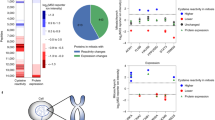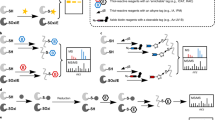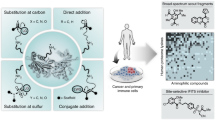Abstract
Current methods used for measuring amino acid side-chain reactivity lack the throughput needed to screen large chemical libraries for interactions across the proteome. Here we redesigned the workflow for activity-based protein profiling of reactive cysteine residues by using a smaller desthiobiotin-based probe, sample multiplexing, reduced protein starting amounts and software to boost data acquisition in real time on the mass spectrometer. Our method, streamlined cysteine activity-based protein profiling (SLC-ABPP), achieved a 42-fold improvement in sample throughput, corresponding to profiling library members at a depth of >8,000 reactive cysteine sites at 18 min per compound. We applied it to identify proteome-wide targets of covalent inhibitors to mutant Kirsten rat sarcoma (KRAS)G12C and Bruton’s tyrosine kinase (BTK). In addition, we created a resource of cysteine reactivity to 285 electrophiles in three human cell lines, which includes >20,000 cysteines from >6,000 proteins per line. The goal of proteome-wide profiling of cysteine reactivity across thousand-member libraries under several cellular contexts is now within reach.
This is a preview of subscription content, access via your institution
Access options
Access Nature and 54 other Nature Portfolio journals
Get Nature+, our best-value online-access subscription
$29.99 / 30 days
cancel any time
Subscribe to this journal
Receive 12 print issues and online access
$209.00 per year
only $17.42 per issue
Buy this article
- Purchase on Springer Link
- Instant access to full article PDF
Prices may be subject to local taxes which are calculated during checkout






Similar content being viewed by others
Data availability
The mass spectrometry data have been deposited at the ProteomeXchange Consortium with the dataset identifier PXD022511. Source data are provided with this paper. SLCAPP data generated during this study are also avaliable using the viewer on the Gygi lab website (https://gygi.hms.harvard.edu/resources.html).
Code availability
The RTS Comet functionality has been released and is available at http://comet-ms.sourceforge.net/. Real-time access to spectral data was enabled by the Thermo Scientific Fusion API (https://github.com/thermofisherlsms/iapi).
References
Long, M. J. C. & Aye, Y. Privileged electrophile sensors: a resource for covalent drug development. Cell Chem. Biol. 24, 787–800 (2017).
Maurais, A. J. & Weerapana, E. Reactive-cysteine profiling for drug discovery. Curr. Opin. Chem. Biol. 50, 29–36 (2019).
Gehringer, M. & Laufer, S. A. Emerging and re-emerging warheads for targeted covalent inhibitors: applications in medicinal chemistry and chemical biology. J. Med. Chem. 62, 5673–5724 (2019).
Zhang, T., Hatcher, J. M., Teng, M., Gray, N. S. & Kostic, M. Recent advances in selective and irreversible covalent ligand development and validation. Cell Chem. Biol. 26, 1486–1500 (2019).
Roberts, A. M., Ward, C. C. & Nomura, D. K. Activity-based protein profiling for mapping and pharmacologically interrogating proteome-wide ligandable hotspots. Curr. Opin. Biotechnol. 43, 25–33 (2017).
Cravatt, B. F., Wright, A. T. & Kozarich, J. W. Activity-based protein profiling: from enzyme chemistry to proteomic chemistry. Annu. Rev. Biochem. 77, 383–414 (2008).
Pace, N. J. & Weerapana, E. Diverse functional roles of reactive cysteines. ACS Chem. Biol. 8, 283–296 (2013).
Murray, C. W. & Rees, D. C. The rise of fragment-based drug discovery. Nat. Chem. 1, 187–192 (2009).
Giles, N. M., Giles, G. I. & Jacob, C. Multiple roles of cysteine in biocatalysis. Biochem. Biophys. Res. Commun. 300, 1–4 (2003).
Bulaj, G., Kortemme, T. & Goldenberg, D. P. Ionization-reactivity relationships for cysteine thiols in polypeptides. Biochemistry 37, 8965–8972 (1998).
Reddie, K. G. & Carroll, K. S. Expanding the functional diversity of proteins through cysteine oxidation. Curr. Opin. Chem. Biol. 12, 746–754 (2008).
Resnick, E. et al. Rapid covalent-probe discovery by electrophile-fragment screening. J. Am. Chem. Soc. 141, 8951–8968 (2019).
Gygi, S. P. et al. Quantitative analysis of complex protein mixtures using isotope-coded affinity tags. Nat. Biotechnol. 17, 994–999 (1999).
Weerapana, E., Speers, A. E. & Cravatt, B. F. Tandem orthogonal proteolysis-activity-based protein profiling (TOP-ABPP) – a general method for mapping sites of probe modification in proteomes. Nat. Protoc. 2, 1414–1425 (2007).
Weerapana, E. et al. Quantitative reactivity profiling predicts functional cysteines in proteomes. Nature 468, 790–797 (2010).
Martell, J. & Weerapana, E. Applications of copper-catalyzed click chemistry in activity-based protein profiling. Molecules 19, 1378–1393 (2014).
Weerapana, E., Simon, G. M. & Cravatt, B. F. Disparate proteome reactivity profiles of carbon electrophiles. Nat. Chem. Biol. 4, 405–407 (2008).
Backus, K. M. et al. Proteome-wide covalent ligand discovery in native biological systems. Nature 534, 570–574 (2016).
Grüner, B. M. et al. An in vivo multiplexed small-molecule screening platform. Nat. Methods 13, 883–889 (2016).
Matthews, M. L. et al. Chemoproteomic profiling and discovery of protein electrophiles in human cells. Nat. Chem. 9, 234–243 (2017).
Bar-Peled, L. et al. Chemical proteomics identifies druggable vulnerabilities in a genetically defined cancer. Cell 171, 696–709 (2017).
Senkane, K. et al. The proteome-wide potential for reversible covalency at cysteine. Angew. Chem. Int. Ed. Engl. 58, 11385–11389 (2019).
Yang, Y., Hahne, H., Kuster, B. & Verhelst, S. H. L. A simple and effective cleavable linker for chemical proteomics applications. Mol. Cell. Proteomics 12, 237–244 (2013).
Qian, Y. et al. An isotopically tagged azobenzene-based cleavable linker for quantitative proteomics. ChemBioChem 14, 1410–1414 (2013).
Nessen, M. A. et al. Selective enrichment of azide-containing peptides from complex mixtures. J. Proteome Res. 8, 3702–3711 (2009).
Rabalski, A. J., Bogdan, A. R. & Baranczak, A. Evaluation of chemically-cleavable linkers for quantitative mapping of small molecule-cysteinome reactivity. ACS Chem. Biol. 14, 1940–1950 (2019).
Okerberg, E. S. et al. Identification of a tumor specific, active-site mutation in casein kinase 1α by chemical proteomics. PLoS ONE 11, e0152934 (2016).
Rao, S. et al. Leveraging compound promiscuity to identify targetable cysteines within the kinome. Cell Chem. Biol. 26, 818–829 (2019).
Zanon, P. R. A., Lewald, L. & Hacker, S. M. Isotopically labeled desthiobiotin azide (isoDTB) tags enable global profiling of the bacterial cysteinome. Angew. Chem. Int. Ed. Engl. 59, 2829–2836 (2020).
Zhang, X., Crowley, V. M., Wucherpfennig, T. G., Dix, M. M. & Cravatt, B. F. Electrophilic PROTACs that degrade nuclear proteins by engaging DCAF16. Nat. Chem. Biol. 15, 737–746 (2019).
Rauniyar, N. & Yates, J. R. Isobaric labeling-based relative quantification in shotgun proteomics. J. Proteome Res. 13, 5293–5309 (2014).
Vinogradova, E. V. et al. An activity-guided map of electrophile-cysteine interactions in primary human T cells. Cell 182, 1009–1026 (2020).
Erickson, B. K. et al. Active instrument engagement combined with a real-time database search for improved performance of sample multiplexing workflows. J. Proteome Res. 18, 1299–1306 (2019).
Schweppe, D. K. et al. Full-featured, real-time database searching platform enables fast and accurate multiplexed quantitative proteomics. J. Proteome Res. 19, 2026–2034 (2020).
Rauniyar, N. & Yates, J. R. Isobaric labeling-based relative quantification in shotgun proteomics. J. Proteome Res. 13, 5293–5309 (2014).
O’Connell, J. D., Paulo, J. A., O’Brien, J. J. & Gygi, S. P. Proteome-wide evaluation of two common protein quantification methods. J. Proteome Res. 17, 1934–1942 (2018).
Li, J. et al. TMTpro reagents: a set of isobaric labeling mass tags enables simultaneous proteome-wide measurements across 16 samples. Nat. Methods 17, 399–404 (2020).
Erickson, B. K. et al. Active instrument engagement combined with a real-time database search for improved performance of sample multiplexing workflows. J. Proteome Res. https://doi.org/10.1021/acs.jproteome.8b00899 (2019).
Lito, P., Solomon, M., Li, L.-S., Hansen, R. & Rosen, N. Allele-specific inhibitors inactivate mutant KRAS G12C by a trapping mechanism. Science 351, 604–608 (2016).
Janes, M. R. et al. Targeting KRAS mutant cancers with a covalent G12C-specific inhibitor. Cell 172, 578–589 (2018).
Kwiatkowski, N. et al. Targeting transcription regulation in cancer with a covalent CDK7 inhibitor. Nature 511, 616–620 (2014).
Browne, C. M. et al. A chemoproteomic strategy for direct and proteome-wide covalent inhibitor target-site identification. J. Am. Chem. Soc. 141, 191–203 (2019).
Lanning, B. R. et al. A road map to evaluate the proteome-wide selectivity of covalent kinase inhibitors. Nat. Chem. Biol. 10, 760–767 (2014).
Haapalainen, A. M. et al. Crystallographic and kinetic studies of human mitochondrial acetoacetyl-CoA thiolase: the importance of potassium and chloride ions for its structure and function. Biochemistry 46, 4305–4321 (2007).
Davies, T. G. & Hyvönen, M. Fragment-based Drug Discovery and X-ray Crystallography (Springer, 2012).
Erlanson, D. A., Davis, B. J. & Jahnke, W. Fragment-based drug discovery: advancing fragments in the absence of crystal structures. Cell Chem. Biol. 26, 9–15 (2019).
Fan, C. H. et al. O6-methylguanine DNA methyltransferase as a promising target for the treatment of temozolomide-resistant gliomas. Cell Death Dis. 4, e876 (2013).
Sharma, S. et al. Role of MGMT in tumor development, progression, diagnosis, treatment and prognosis. Anticancer Res. 29, 3759–3768 (2009).
Nagel, Z. D. et al. Fluorescent reporter assays provide direct, accurate, quantitative measurements of MGMT status in human cells. PLoS ONE 14, e0208341 (2019).
Beharry, A. A., Nagel, Z. D., Samson, L. D. & Kool, E. T. K. Fluorogenic real-time reporters of DNA repair by MGMT, a clinical predictor of antitumor drug response. PLoS ONE 11, e0152684 (2016).
Du, G. et al. Structure-based design of a potent and selective covalent inhibitor for SRC kinase that targets a P-loop cysteine. J. Med. Chem. 63, 1624–1641 (2020).
Gurbani, D. et al. Structure and characterization of a covalent inhibitor of Src kinase. Front. Mol. Biosci. 7, 81 (2020).
Campaner, E. et al. A covalent PIN1 inhibitor selectively targets cancer cells by a dual mechanism of action. Nat. Commun. 8, 15772 (2017).
Dubiella, C. et al. Sulfopin, a selective covalent inhibitor of Pin1, blocks Myc-driven tumor initiation and growth in vivo. Preprint at bioRxiv https://doi.org/10.1101/2020.03.20.998443 (2020).
Sears, R. C. The life cycle of c-Myc: from synthesis to degradation. Cell Cycle 3, 1131–1135 (2004).
Nam, J. et al. Disruption of the Myc-PDE4B regulatory circuitry impairs B-cell lymphoma survival. Leukemia 33, 2912–2923 (2019).
Carter, A. J. et al. Target 2035: probing the human proteome. Drug Discov. Today 24, 2111–2115 (2019).
Mullard, A. A probe for every protein. Nat. Rev. Drug Discov. 18, 733–736 (2019).
Eng, J. K. et al. A deeper look into Comet – implementation and features. J. Am. Soc. Mass Spectrom. 26, 1865–1874 (2015).
Eng, J. K., Jahan, T. A. & Hoopmann, M. R. Comet: an open-source MS/MS sequence database search tool. Proteomics 13, 22–24 (2013).
Yu, Q. et al. Benchmarking the Orbitrap tribrid eclipse for next generation multiplexed proteomics. Anal. Chem. 92, 6478–6485 (2020).
Motiwala, H. F., Kuo, Y. H., Stinger, B. L., Palfey, B. A. & Martin, B. R. Tunable heteroaromatic sulfones enhance in-cell cysteine profiling. J. Am. Chem. Soc. 142, 1801–1810 (2020).
Dephoure, N. & Gygi, S. P. Hyperplexing: a method for higher-order multiplexed quantitative proteomics provides a map of the dynamic response to rapamycin in yeast. Sci. Signal. 5, rs2 (2012).
Hacker, S. M. et al. Global profiling of lysine reactivity and ligandability in the human proteome. Nat. Chem. 9, 1181–1190 (2017).
Hahm, H. S. et al. Global targeting of functional tyrosines using sulfur-triazole exchange chemistry. Nat. Chem. Biol. 16, 150–159 (2020).
Navarrete-Perea, J., Yu, Q., Gygi, S. P. & Paulo, J. A. Streamlined Tandem Mass Tag (SL-TMT) protocol: an efficient strategy for quantitative (phospho)proteome profiling using tandem mass tag-synchronous precursor selection-MS3. J. Proteome Res. 17, 2226–2236 (2018).
McAlister, G. C. et al. Increasing the multiplexing capacity of TMTs using reporter ion isotopologues with isobaric masses. Anal. Chem. 84, 7469–7478 (2012).
Beausoleil, S. A., Villén, J., Gerber, S. A., Rush, J. & Gygi, S. P. A probability-based approach for high-throughput protein phosphorylation analysis and site localization. Nat. Biotechnol. 24, 1285–1292 (2006).
Elias, J. E. & Gygi, S. P. Target-decoy search strategy for increased confidence in large-scale protein identifications by mass spectrometry. Nat. Methods 4, 207–214 (2007).
Huttlin, E. L. et al. A tissue-specific atlas of mouse protein phosphorylation and expression. Cell 143, 1174–1189 (2010).
Komsta, L. & Novomestky, F. moments: moments, cumulants, skewness, kurtosis and related tests. CRAN https://cran.r-project.org/web/packages/moments/moments.pdf (2015).
Wickham, H. ggplot2: Elegant Graphics for Data Analysis (Springer, 2016).
R Core Team. R: A Language and Environment for Statistical Computing (R Foundation for Statistical Computing, 2019).
Acknowledgements
We thank the members of the Gygi laboratory for fruitful discussions about this work. We thank A. Reed for assistance with mouse experiments. We thank F. Ferguson, G. Du and N. Gray for providing SM-71 and TL13-68 for SRC experiments. This work was supported in part through a sponsored research agreement with Google Ventures and Third Rock Ventures and grants from the NIH (nos. GM67945 to S.P.G., CA231991 to B.F.C. and CA217809 to E.T.K.), Dana-Farber Cancer Institute Claudia Adams Barr Program for Innovative Cancer Research Award and the Hale Family Center for Pancreatic Cancer Research (to J.D.M.).
Author information
Authors and Affiliations
Contributions
M.K., D.C.M., A.S.G. and E.V.V. prepared samples for proteomic analysis. M.K., D.C.M. and D.K.S. collected the proteomics datasets. D.K.S. implemented the Orbiter search strategy. D.K.S., N.J.B. and D.P.N. built the community resource website. D.P.N. performed data interpretation and skewness calculations. M.K. and D.C.M. synthesized and purified desthiobiotin. D.L.W. and E.T.K. synthesized the MGMT-specific probe, NR-1. E.V.V. and B.F.C. provided the scout fragments and performed the ibrutinib mouse study. M.K., D.C.M., D.K.S., D.P.N., J.D.M., B.F.C. and S.P.G. interpreted the results. M.K. and S.P.G. conceived the project, improved the workflow and wrote the manuscript.
Corresponding author
Ethics declarations
Competing interests
B.F.C. is a founder and scientific advisor of Vividion Therapeutics. S.P.G. is a member of the scientific advisory boards of Thermo Fisher Scientific, Cell Signaling Technology and Casma Therapeutics. S.P.G. is a founder of Cedilla Therapeutics and a scientific advisor to Third Rock Ventures. All other authors declare no competing interests.
Additional information
Peer review information Nature Biotechnology thanks Marcus Bantscheff and the other, anonymous, reviewer(s) for their contribution to the peer review of this work.
Publisher’s note Springer Nature remains neutral with regard to jurisdictional claims in published maps and institutional affiliations.
Supplementary information
Supplementary Information
Supplementary Figs. 1–7.
Supplementary Table 1
CR for cells treated with increasing concentrations of ARS16-20.
Supplementary Table 2
CR for cells treated with increasing concentrations of THZ1.
Supplementary Table 3
CR for mice treated with increasing concentrations of ibrutinib.
Supplementary Table 4
CR for cell lysates treated with scout fragments.
Supplementary Table 5
Information on compounds used in large electrophile library screening.
Supplementary Table 6
CR for HCT116 cells treated with electrophile library.
Supplementary Table 7
CR for HEK293T cells treated with electrophile library.
Supplementary Table 8
CR for PaTu-8988T cells treated with electrophile library.
Supplementary Table 9
Whole-proteome raw data and protein differences after treatment with CL71.
Supplementary Data
Synthesis scheme for generation of desthiobiotin-IA, including hrMS2 and NMR.
Source data
Source Data Fig. 1
Uncropped immunoblot for data used in Fig. 6e.
Rights and permissions
About this article
Cite this article
Kuljanin, M., Mitchell, D.C., Schweppe, D.K. et al. Reimagining high-throughput profiling of reactive cysteines for cell-based screening of large electrophile libraries. Nat Biotechnol 39, 630–641 (2021). https://doi.org/10.1038/s41587-020-00778-3
Received:
Accepted:
Published:
Issue Date:
DOI: https://doi.org/10.1038/s41587-020-00778-3
This article is cited by
-
Meta-learning-based Inductive logistic matrix completion for prediction of kinase inhibitors
Journal of Cheminformatics (2024)
-
Functionalizing tandem mass tags for streamlining click-based quantitative chemoproteomics
Communications Chemistry (2024)
-
Chemoproteomic capture of RNA binding activity in living cells
Nature Communications (2023)
-
N-Acryloylindole-alkyne (NAIA) enables imaging and profiling new ligandable cysteines and oxidized thiols by chemoproteomics
Nature Communications (2023)
-
Direct mapping of ligandable tyrosines and lysines in cells with chiral sulfonyl fluoride probes
Nature Chemistry (2023)



